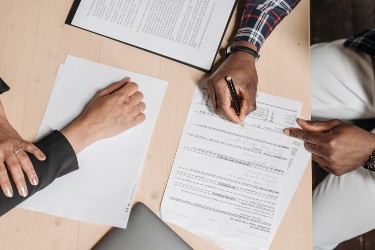
The accident is over, but the journey has just begun. Over the next few days, you hear a lot about “soft tissue” and “discs.” The stress and anxiety keep you up at night.
You ask yourself tough questions like, Am I going to be okay? Can I afford another car? and How can I possibly pay for all this?
The person who caused the accident and their insurance company may want you to handle all this by yourself. But the truth is, you don’t have to. If another’s negligence or misconduct caused your injury, you may have a claim.
In this guide, we will go over some of the basics of how to file a personal injury lawsuit in California.
Step 1: Document Everything
It’s a good idea to start taking pictures of the accident scene as soon as it is safe to do so. If you’re not able to take pictures, you might be able to ask a witness to do so for you.
Speaking of witnesses, try to collect their contact information and ask them for copies of any pictures they took. If the police come to the scene, they will make a report of the accident as well. Finally, take some time to jot down your memory of the accident, and be as detailed as possible.
Step 2: See a Doctor
Injuries are not always readily apparent. It can take days or even weeks for some injuries to manifest. It’s important to talk to a doctor after an accident. You might need an X-ray, MRI, or CT scan to determine what injuries you have.
If something feels off, make sure you mention it. Treatment varies depending on your injury but could include physical therapy, medication, or surgery.
Step 3: Talk to a Lawyer
Filing a California personal injury lawsuit can get complicated. Throw in doctor’s visits, anxiety, and replacing damaged property, and it can feel impossible to do anything else.
An experienced personal injury attorney can take much of that burden off your shoulders. The situation that feels so foreign and overwhelming for you is often something a personal injury attorney deals with on a regular basis.
Step 4: Determine Standing
Your lawyer will probably go over the case with you and help you determine if you have standing. Standing refers to the right to be able to file a lawsuit. If you were not a party to the accident or you waited too long then you might not have the standing to file the lawsuit.
Step 5: Figure Out Who Is Responsible
A personal injury claim is not always black and white. It can be difficult to determine who the responsible parties are. For example, if you are hit by a commercial vehicle, you would probably file suit against the driver. But what about their employer?
They may also be responsible, especially if the driver has a poor safety record. The driver and the company should also have an insurance policy to cover damages from a wreck.
These are all important factors in determining liability. It’s also important to be honest with your attorney about your own responsibility. If you think you may have contributed to the accident—by speeding for example—be sure to let your attorney know.
Step 6: File an Insurance Claim
You might need to file an insurance claim after an accident. The business or person responsible may have an insurance policy that covers accidents and injuries.
Don’t assume the insurance company will pay right off the bat though. You and your lawyer may need to send a demand letter or file a lawsuit to get adequate payment for your damages.
Step 7: Determine Where to File Your Lawsuit
The venue is the place where you are filing a lawsuit. When you file a personal injury lawsuit in California it needs to be in the proper venue. Normally, this can be the place where the accident occurred, where the defendant lives, or where you live. Your attorney can help you determine which venue is proper.
Step 8: Check the Statute of Limitations
You will need to know how long you have to file a personal injury claim. You have only a limited amount of time to file your personal injury lawsuit. In California, the statute of limitations for personal injury claims is two years from the time the accident occurs. However, this date can be extended in limited circumstances.
Step 9: Send a Demand Letter
It may be possible to resolve your claims without filing a lawsuit. Your lawyer may send a demand letter to the insurance company and the responsible parties.
Demand letters give a brief overview of the claims and how much is being asked for. There could be some back and forth before everyone agrees on a settlement amount.
Step 10: File a California Personal Injury Lawsuit
If settlement talks break down, then it may be time to file your lawsuit. You will need to have an idea of what happened, what damages were done, who the responsible parties are, and when and where the suit will need to be filed.
Fortunately, if you have followed the above steps and discussed them with an attorney, you will likely have what you need.
Talk to a Personal Injury Attorney Today
The Saeedian Law Group can help you file your personal injury lawsuit in California. Our team has worked with accident victims since 2009 and is committed to helping you get fair compensation for your injuries.
If you’ve been in an accident, you’ve already suffered enough. Let us guide you through the personal injury process, so you can focus on getting better. Contact us today at (310) 288-3000.